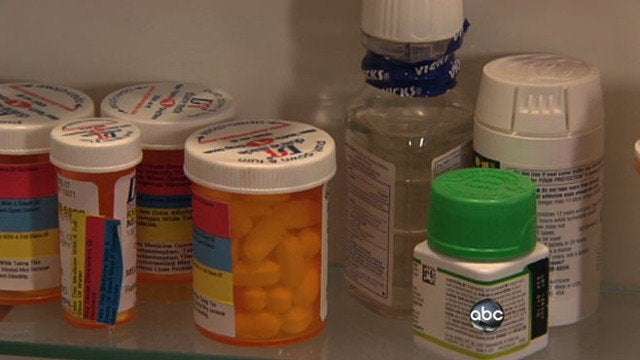If there is one place you shouldn't store your medication, it's the exact place where you probably are: the medicine cabinet in your bathroom.
"The medicine cabinet in the bathroom is the worst place," said Selig Corman, director of Professional Affairs at the Pharmacists Society of the State of New York.
Most medicine should be stored at room temperature, between 68 and 77 degrees, and kept away from moisture. Because the bathroom is prone to high temperatures and humidity, it is a poor place to keep drugs.
"An egg kept at an extreme temperature of heat becomes cooked and that could happen with tablets, with certain gelatin capsules, and that could alter the chemistry of the product." Corman said. "Something as simple as aspirin ... when aspirin reacts with moisture it becomes a different chemical ... something that is sold as a corn remover. You wouldn't want to ingest a corn remover."
Storing medication in an area with temperatures between 58 and 86 degrees is usually acceptable, Corman said, but two things can happen if the temperature does not stay in the proper range. The first is that the drug might lose its effectiveness and the second is that the medication could become harmful if its chemistry has changed.
Corman and Dr. Grant Fowler, professor of family medicine at the University of Texas Health Science Center at Houston, say travel is often when drugs are exposed to extreme conditions. Here are their tips on how to keep medications safe during transit.
Don't check drugs when flying. Put them in your carry-on luggage.
Don't put drugs in the trunk when driving. Keep them in the car when driving and take them with you when you park.
Choose overnight shipping for mail-order drugs. If you work, have the medication shipped to your office.
"If they [the drugs] sit out on your front porch for hours to even days, in some situations your pretty much are going to guarantee they are going to exceed those excursions," Fowler said.
An FDA study from 1995 found that the interior temperature of a black mailbox can reach as high as 136 degrees when the ambient air temperature was 101 degrees.
Insulins and other injectables, which are supposed to be refrigerated, are especially vulnerable to extreme temperatures.
"They could freeze, which would ruin it. They could overheat which would ruin it," Fowler said.
When it comes to pills or tablets, Corman said, you can usually see a difference in their appearance if they have been adversely affected by severe temperatures or moisture. The color often changes and tablets that were once shiny might look dull.
If you have any doubts about the medication you're taking, he said, you should consult your pharmacist. Corman advised people to speak with their pharmacist about the proper way to store medication whenever they begin taking a new one.
ABC News' Alice Maggin contributed to this story.

friggyturt on November 7th, 2019 at 02:49 UTC »
I keep mine in a cupboard the kitchen.
SpecialAgentHungLo on November 7th, 2019 at 02:22 UTC »
Also because your friend’s cousin who they neglected to tell you just got out of rehab and asked to use your bathroom will take every single thing you have in there, then categorically deny they touched anything despite being the only possible culprit.
Astark on November 7th, 2019 at 01:55 UTC »
"An egg kept at an extreme temperature of heat becomes cooked and that could happen with tablets, with certain gelatin capsules, and that could alter the chemistry of the product." Corman said. "Something as simple as aspirin ... when aspirin reacts with moisture it becomes a different chemical ... something that is sold as a corn remover. You wouldn't want to ingest a corn remover."
So, either the author's understanding of what a medicine cabinet is leaves something to be desired, or there's a bit of hyperbole here. I'm sure this sickens and kills about as many people as leaving your toothbrush exposed.